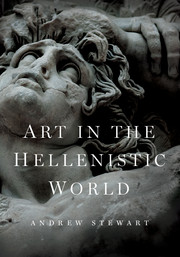Book contents
- Frontmatter
- Contents
- List of Illustrations
- Preface
- Introduction
- 1 Settlement
- 2 Power
- 3 Victory
- 4 Benefaction
- Focus I The Great Altar of Pergamon
- Focus II Hellenistic Mosaics
- Appendix A The Artist
- Appendix B Kallixeinos of Rhodes on the Wonders of Alexandria
- Glossary
- Timeline
- Biographical Sketches
- Select Bibliography and Further Reading
- References
- Sources of Illustrations
- Index
Introduction
Published online by Cambridge University Press: 05 October 2014
- Frontmatter
- Contents
- List of Illustrations
- Preface
- Introduction
- 1 Settlement
- 2 Power
- 3 Victory
- 4 Benefaction
- Focus I The Great Altar of Pergamon
- Focus II Hellenistic Mosaics
- Appendix A The Artist
- Appendix B Kallixeinos of Rhodes on the Wonders of Alexandria
- Glossary
- Timeline
- Biographical Sketches
- Select Bibliography and Further Reading
- References
- Sources of Illustrations
- Index
Summary
Inside a shallow drinking or libation bowl of dazzling, multilayered, semiprecious sardonyx (Figure 1) – cream, red-brown, and almost eight inches wide – an idyllic scene emerges. Carved cameo-fashion into the creamy third layer of this huge, semitranslucent gemstone, eight figures compete for our attention.
At center, a vigorous young man, clad only in a skimpy loincloth, holds a seed bag, a knife, and a bow-shaped object that an ancient viewer would have recognized as the shaft of a plough. At left, a bearded old man (also bare-chested but much less sexy) sits against a tree and holds a horn of plenty, or cornucopia. Below them, a bare-breasted woman (a surefire attention-getter rediscovered on European beaches in the 1960s), in Egyptian Isis dress and with an Egyptian hairdo, reclines on a sphinx and holds two ears of grain. Suggestively, the cornucopia, plough shaft, and grain all line up just to the left of center.
At right recline two other women, also topless and nearly as well endowed as the one on the sphinx. The first proffers a bowl somewhat like the one under discussion, and the second reclines against a sheaf of wheat and holds another cornucopia. Finally, two comely youths, naked but for their billowing cloaks, soar across the sky above, one blowing a conch shell and the other turning to watch him. Meanwhile, on the bowl’s underside, a huge Gorgon’s head, or Gorgoneion, wreathed with writhing snakes, glares balefully at anyone tempted to disturb the drinker as he tilts it to imbibe.
As for the bowl’s material, sardonyx is a variant of onyx, a banded chalcedony so named because its internal layers are cream-colored, like the tip of a fingernail (onyx in Greek), and its colored bands are shades of red, or sard (allegedly because it was first identified at Sardis in western Anatolia), rather than black. Consisting of fine intergrowths of quartz and moganite, onyx is cryptocrystalline: formed of crystals that are almost invisible even under a microscope. Its colored bands run more or less parallel to each other, encouraging this kind of carving in relief, whereas the chaotic banding of agates is far better suited to engraving, or intaglio, work.
- Type
- Chapter
- Information
- Art in the Hellenistic WorldAn Introduction, pp. 1 - 25Publisher: Cambridge University PressPrint publication year: 2014



